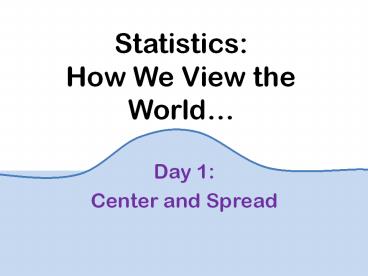Statistics: How We View the World - PowerPoint PPT Presentation
Title:
Statistics: How We View the World
Description:
Statistics: How We View the World Day 1: Center and Spread One-Minute Question Find the mean of the following grades: {70, 70, 80, 92, 98, 100} One-Minute Question ... – PowerPoint PPT presentation
Number of Views:78
Avg rating:3.0/5.0
Title: Statistics: How We View the World
1
Statistics How We View the World
- Day 1
- Center and Spread
2
One-Minute Question
- Find the mean of the following grades
- 70, 70, 80, 92, 98, 100
3
One-Minute Question
- Arithmetic Mean average (7070809298100)/6
- 85
4
Review
- Find all the other Measures of Central Tendency
that you know - 70, 70, 80, 92, 98, 100
5
Review
- Did you name
- Median 86
- Mode 70
- 70, 70, 80, 92, 98, 100
6
Review
- Besides measures of Central Tendency, what else
do we care about?
7
Review
- Find all the Measures of Dispersion that you
know - 70, 70, 80, 92, 98, 100
8
Review
- Range 30
- Mean Absolute Deviation
- 11.67
- Inner-Quartile Range (IQR)
- 28
- 70, 70, 80, 92, 98, 100
9
New Concept
- Mean Absolute Deviation is rarely used, but
Standard Deviation is used quite often - 70, 70, 80, 92, 98, 100
10
To find Standard Deviation
- Find each numbers difference
- from the mean.
- 2. Square these differences.
- Find the average of these
- squared differences.
- 4. Take the square root of your result.
- 70, 70, 80, 92, 98, 100
11
Standard Deviation
- In other words
- Standard Deviation s
- s
- 70, 70, 80, 92, 98, 100
12
Standard Deviation
- In other words
- Standard Deviation
- 70, 70, 80, 92, 98, 100
13
Variance (Standard Deviation)2
14
So, Who Cares??
- All of us who are Normal!
15
So, Who Cares??
- Remember that histograms are graphs of the
distribution of data??? - Well, think about other more general
distributions.
16
So, Who Cares??
- Suppose we roll a single die 1,000,000 times.
- What should the distribution of number of dots on
the top face look like? - Uniform distribution
- (Close to constant!)
Frequency
1 2 3 4 5 6
17
So, Who Cares??
- What should the distribution be for a VERY, VERY
easy test? - It should be skewed to the left.
- (There should be lots of data to the right of the
graph.)
Frequency
F D C B A
18
So, Who Cares??
- But the heights of 20 year old males is normal.
- That means that the data forms a bell-shape that
is symmetric about the mean.
Frequency
19
Furthermore, the percentage of the area covered
by each standard deviation from the mean is shown
by this graph.
20
So, suppose the mean of a normal distribution is
100 with a standard deviation of 15. What
percentage of the scores lie between 85 and 115?
21
So, suppose the mean of a normal distribution is
100 with a standard deviation of 15. What
percentage of the scores lie between 70 and 115?
22
In order to find how many standard deviations
away an x value is from the mean we use a
z-score.
23
If the mean of a set of test grades is 84 with a
standard deviation of 6, what is the z-score for
a test grade of 96?
What percent of the other students scored lower
that a 96?
24
For homework,work all the odd problems on pages
262 and 266






























![❤[PDF]⚡ State Rankings 2019: A Statistical View of America PowerPoint PPT Presentation](https://s3.amazonaws.com/images.powershow.com/10047370.th0.jpg?_=20240604107)
